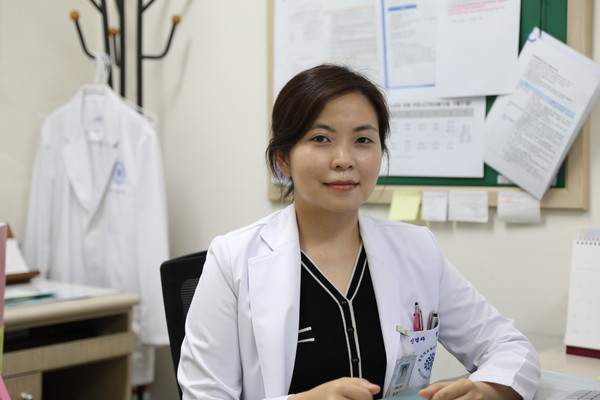Myongji Hospital has launched a brain tissue bank without any state funding to speed up research, diagnosis, and treatment of brain diseases.
The brain tissue bank receives brain tissue donations from patients with various brain diseases such as dementia and Parkinson's disease, stroke, mental disorder, autism, and epilepsy and their families. With the donated tissues, the bank helps research for the development of therapeutics.
Myongji Hospital is the first private Korean medical institution to open a brain tissue bank. Given a significant amount of money and workforce required to receive brain donations and manage them, it is unprecedented that a private hospital opened a brain tissue bank, observers said.
Korea Biomedical Review recently met with Professor Jung Young-hee at the Neurology Department of Myongji Hospital to learn why the hospital launched the brain tissue bank and its next steps.

Question: Why did Myongji Hospital establish a brain tissue bank?
Answer: Since 2016, the Korea Centers for Disease Control and Prevention (KCDC) has been conducting the National Dementia Brain Bank of Korea project where Samsung Medical Center, Seoul National University Hospital, and Pusan National University Hospital participate.
By collecting advanced brain research resources such as brain tissue, brain images, clinical information, and human body resources, the project aims to enhance local dementia research and promote dementia diagnosis and commercialization of therapeutics.
Myongji Hospital is also preparing to participate in the project. But before that, we decided to run our brain bank because we recognized the urgency and necessity of brain research. Myongji Hospital is the first private hospital to establish and operate a brain tissue bank without government funding.
Q: How would you assess the local environment for brain research?
A: Cancer research is very active because physicians can collect tissues from surgery. But in cases of brain diseases such as Alzheimer’s or Parkinson’s disease, researchers can rarely earn brain tissues through surgery or biopsy, although it is crucial to check brain tissues for research. It was impossible for medical institutions without a brain tissue bank to receive brain tissue donations until April. Fortunately, such regulations have been eased recently, and it has led to a private hospital’s launching of a brain tissue bank.
Q: Why was it difficult to use brain tissues for research?
A: Human brains show significant differences between races in particular. In some cases, it was impossible to combine brain-related data from different countries. So, it is essential to study brains domestically. Local researchers have recognized this, and the demand for brain tissues has been high.
However, in reality, it was difficult to obtain even blood from brain disease patients. It has been only a few years since we collected blood samples from patients in a large cohort. Currently, large-scale hospitals are mainly conducting next-generation sequencing (NGS) tests related to brain diseases using blood, but this was not easy in the past.
As the importance of molecular biology became important for research on brain diseases, many have attempted to connect information of blood, cerebrospinal fluid, brain tissues, and clinical information to diagnose and treat brain diseases. This also means that the importance of collecting brain disease patients’ blood and cerebrospinal fluid has increased.
Q: For active brain disease research, there should be many brain donations. But the public does not seem to have built a social consensus on this issue. What do you think?
A: Families, who have seen patients with dementia suffer for a long time, understand why dementia treatments need improvement. However, under the influence of Confucian funeral culture in Korea, it is not easy to agree on a brain donation that requires brain extraction. Fortunately, cremation has become more frequent, and the awareness of organ donation is gradually changing. As the consensus about the necessity and importance of brain research is building, I think brain donation awareness will be improved.
Q: How do you manage donated brain tissues?
A: The U.S. and Europe have operated and managed brain tissue banks through networks to study brains for a long time actively. So, related protocols have already been established internationally. Korean hospitals such as SNUH have benchmarked these protocols and published the results in papers.
Myongji Hospital will also operate a brain tissue bank in line with these international protocols. As we can’t get many brain donations, there should be standardized brain collection and management rules for meaningful research and experiments. The KCDC and the three hospitals are meeting regularly to build a brain tissue operating system. Myongji Hospital also participated in this meeting recently and will continue to work together.
Q: Is there a brain disease study that Myongji Hospital’s brain tissue bank pays special attention to?
A: We plan to focus our research on Alzheimer’s first. Brain donations are essential for brain research. As we need a control group, we will try to collect cases of healthy patients and patients with brain diseases that have not been adequately diagnosed.
Q: How do you plan to encourage brain donations?
A: It is not easy to obtain the brain of a dementia patient. Even if a patient or their family is willing to donate the brain in the early stages of dementia, it takes a long time to get the brain. There are more than 800 brain donation registrants at SNUH or Samsung Medical Center. Still, hospitals can get only about 100 brains. Brain donations need a long time of waiting and steady persuasion towards patients and families.
So, we plan to promote donation culture through posters and brochures that encourage brain donation. Also, we will encourage brain donations from patients with end-stage brain diseases through cooperation with nursing homes.

